
The Hypocreales are an order of fungi within the class Sordariomycetes. In 2008, it was estimated that it contained some 237 genera, and 2647 species in seven families. Since then, a considerable number of further taxa have been identified, including an additional family, the Stachybotryaceae. Wijayawardene et al. in 2020 added more families and genera to the order. According to the Catalog of Life, As of April 2021 the Hypocreales contains 6 families, 137 genera, and 1411 species. Hyde et al. (2020a) listed 14 families under Hypocreales, while, Wijayawardene et al. (2022) accepted 15 families in the order, where Cylindriaceae was additionally added. Earlier, Hyde et al. (2020a) had placed Cylindriaceae in class Xylariomycetidae. Samarakoon et al. (2022) agreed. Hence, Cylindriaceae should have been excluded from Hypocreales and placed in Xylariomycetidae. Xiao et al. (2022) recently introduced a new family Polycephalomycetaceae to Hypocreales.
Spegazzinia is a genus of widely distributed mitosporic ascomycete fungi in the family Didymosphaeriaceae.As accepted by Wijayawardene et al. 2020.

Capnodiales is a diverse order of Dothideomycetes, initially based on the family Capnodiaceae, also known as sooty mold fungi. Sooty molds grow as epiphytes, forming masses of black cells on plant leaves and are often associated with the honeydew secreted by insects feeding on plant sap. This diverse order has been expanded by the addition of several families formerly thought unrelated and now also includes saprobes, endophytes, plant pathogens, lichens and rock-inhabiting fungi. The new additions include the genus Mycosphaerella containing the causal agents of several economically important crop and tree diseases. A small number of these fungi are also able to parasitise humans and animals, including species able to colonise human hair shafts.

Piedraia hortae is a superficial fungus that exists in the soils of tropical and subtropical environments and affects both sexes of all ages. The fungus grows very slowly, forming dark hyphae, which contain chlamydoconidia cells and black colonies when grown on agar. Piedraia hortae is a dermatophyte and causes a superficial fungal infection known as black piedra, which causes the formation of black nodules on the hair shaft and leads to progressive weakening of the hair. The infection usually infects hairs on the scalp and beard, but other varieties tend to grow on pubic hairs. The infection is usually treated with cutting or shaving of the hair and followed by the application of anti-fungal and topical agents. The fungus is used for cosmetic purposes to darken hair in some societies as a symbol of attractiveness.
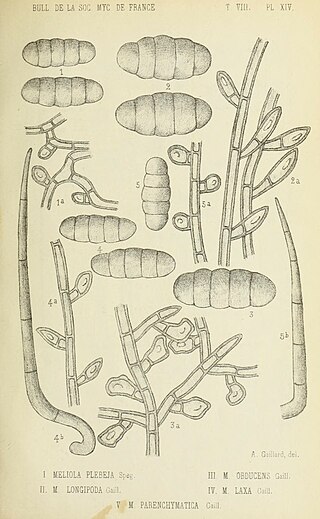
Meliola is a large genus of fungi in the family Meliolaceae. It was circumscribed by Swedish mycologist Elias Magnus Fries in 1825.

The Tubeufiaceae are a family of fungi in the order Tubeufiales of the class Dothideomycetes. The family was circumscribed in 1979 by mycologist Margaret Elizabeth Barr-Bigelow.
The Asterinaceae are a family of fungi in the class Asterinales.
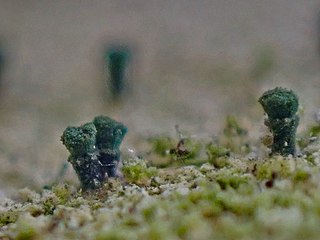
Microcalicium is a genus of lichen-forming fungi in the order Pertusariales. It is the only genus in the monotypic family Microcaliciaceae. These taxa were circumscribed by the Finnish lichenologist Edvard August Vainio in 1927, with Microcalicium disseminatum assigned as the type species.
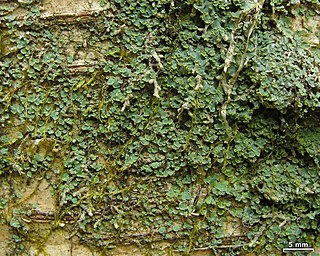
Normandina is a genus of lichen-forming fungi in the family Verrucariaceae. It has five species of crustose and squamulose (scaly) lichens.
The Piedraiaceae is a monotypic family of fungi in the Ascomycota, class Dothideomycetes, within the Capnodiales order.
Phragmocapnias is a genus of fungi in the family Capnodiaceae.
Nipholepis is a little-known fungal genus in the order Arthoniales. The genus has not been placed into a family. It is a monotypic genus, containing the single species Nipholepis filicina, found in Venezuela. Both the genus and species were described in 1935 by German mycologist Hans Sydow. Nipholepis filicina is an epiphytic fungus, living on the surface of plant leaves. Sydow found the fungus forming minute white flecks on the lower frond surfaces of the fern Diplazium expansum, the upper surface of which was covered in algae, mosses, and lichens. He noted a resemblance to the lichen Myxotheca hypocreoides, a member of the family Arthoniaceae.

The Anthracoideaceae are a family of smut fungi in the order Ustilaginales. Collectively, the family contains 20 genera and 198 species. Anthracoideaceae was circumscribed by the Bulgarian mycologist Cvetomir M. Denchev in 1997.
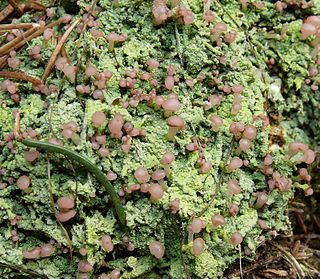
Baeomyces is a genus of lichenized fungi in the family Baeomycetaceae. Members of Baeomyces are commonly called cap lichens. The genus was circumscribed by German mycologist Christiaan Hendrik Persoon in 1794. Although Persoon did not designate a type species in his original description of the genus, Frederick Clements and Cornelius Lott Shear assigned Baeomyces byssoides as the type in 1931.
Ameson is a genus of microsporidia belonging to the family Pereziidae.

Caliciales is an order of mostly lichenized fungi in the class Lecanoromycetes. It consists of two families: Caliciaceae and Physciaceae, which together contain 54 genera and more than 1200 species. The order was circumscribed by American botanist Charles Edwin Bessey in 1907.
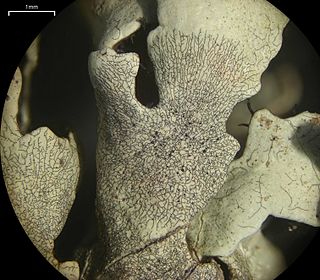
Lichenostigmatales is an order of fungi in the class Arthoniomycetes. It contains the single family Phaeococcomycetaceae. Lichenostigmatales was circumscribed in 2014 by Damien Ertz, Paul Diederich, and James D. Lawrey, with genus Lichenostigma assigned as the type. Using molecular phylogenetics, they identified a lineage of taxa in the Arthoniomycetes that were phylogenetically distinct from the order Arthoniales. Species in the Lichenostigmatales include black yeasts, lichenicolous, and melanised rock-inhabiting species.
Pyrenidium is a genus of lichenicolous (lichen-dwelling) fungi. It is the only genus in the family Pyrenidiaceae. It has 13 species.
Gemmaspora is a single-species fungal genus of uncertain familial placement in the order Verrucariales. It contains Gemmaspora lecanorae, a lichenicolous (lichen-dwelling) fungus that parasitises the lichen genus Aspicilia. The genus was proposed in 2007 by David Hawksworth and Gökhan Halici to contain the fungus formerly known as Adelococcus lecanorae. This species, originally described by Roger-Guy Werner in 1963, occurs in Syria and Turkey.
Austroroccella is a single-species genus in the family Roccellaceae. It contains Austroroccella gayana, a saxicolous (rock-dwelling), fruticose lichen. This lichen produces dark to black discs lacking pruina, and it contains roccellic acid as its only lichen product. The genus was circumscribed in 2013 by Anders Tehler, Martin Irestedt, and Damien Ertz based on molecular phylogenetic analysis that showed that the species belongs in an isolated clade in the Roccellaceae along with Dendrographa, Syncesia, and Roccellina.










